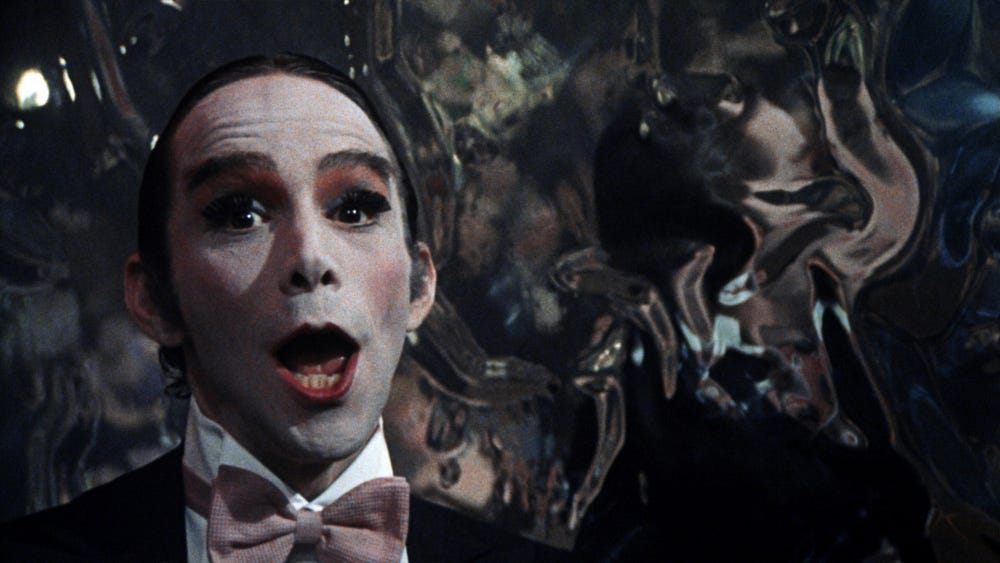Sitting Pretty: Some Thoughts on Bob Fosse’s “Cabaret”
My intro to IFC Center’s 35mm screening of “Cabaret”

Acid irony ignites Cabaret. “Here, life is beautiful,” the Master of Ceremonies (Joel Grey) proclaims, when just moments before, Bob Fosse and cinematographer Geoffrey Unsworth had set their camera to look into the smeary and blurred out mirror, offering a distorted view of the audience. In the original 1966 Broadway production, it was just as blunt: a large mirror, courtesy of Hal Prince and Boris Aronson, was suspended in midair, the spectators forced to view themselves, watching themselves watching.
Prince, who by the time 1966 rolled around had directed She Loves Me (based on the same play that The Shop Around the Corner and You’ve Got Mail are adaptations of) and had produced Fiddler on the Roof, could sense the tides turning for the American Theatre and for popular culture itself. Inspired by a photograph in Life Magazine of a bunch of good ol’ boys snarling in the face of a photographer, behind which was a young Black girl, he not only surmised that the theater should begin to reflect, or refract, the world as it was (a departure from the “traditions” of Rodgers and Hammerstein and the feel good book musicals of the golden era of Broadway) but also experiment with what the form itself could do. Around the same time, Hollywood was experiencing much the same upheaval, with 1967’s Best Picture Oscar race a headbut between the old generation and the new, featuring nominees Bonnie and Clyde, In the Head of the Night, The Graduate, Guess Who’s Coming to Dinner, and Doctor Doolittle. The Vietnam War, the Civil Rights Movement, and the simmering fury of the second wave feminist movement and the modern LGBTQ rights movement was turning society, which we live in, into a pressure cooker, and its art the meal. Adapted from John Van Druten’s play I Am a Camera, itself adapted from Christopher Isherwood’s collected semi-autobiographical writings about his time in Weimar era Berlin, Goodbye to Berlin and Mr. Norris Changes Trains (known as The Berlin Stories), Cabaret, with a book by Joe Masteroff and music and lyrics by John Kander and Fred Ebb, would blowtorch a new path for musical theatre, as inspired by Brecht as it was the showbizzy pastiche of Cole Porter.
The Master of Ceremony’s snarky declaration of the performance space as the other worldly realm of beauty got to be the Molotov thrown at the theater and cinematic establishments, who prized beauty (and the filmic image) above the respective apparatuses’ malleability as a political tool. Or it’s ability to less capture the times than produce a facsimile of them. So for ugly times, an ugly musical, the glitz of the last studio gamble HELLO, DOLLY!, scalded off like skin to hair curler. The Emcee is caked in dirty white makeup, his lips made up like an evil kewpie doll in burgundy, his sexuality leering and androgynous. The dancers, under Fosse’s direction and choreography, are just as palely made up, their eyes slightly drooping; and yet their bodies, caged in by the frame, are precise. If their movements are rote, the product of night after night after night entertaining expats and tourists and queers and sex workers and business men and goodtime girls, you wouldn’t be able to tell given the precision of their movements. When anyone, the dancers or the Emcee or even the illustrious Sally Bowles, sets foot on the stage floor of the Kit Kat Klub, they are in another world, caught up in the light, swallowed up by the spectacle. At the center of Cabaret’s amoral universe is the gradual dissolution of the belief that spectacle in and of itself is beautiful. Spectacle is awesome, a totality that explodes any qualitative notions of beauty or ugliness. It is narcotic.
The toast of Mayfair, Fraulein Sally Bowles, as portrayed by an Academy Award winning Liza with a Z, isn’t simply addicted to the spotlight, to the promise of fame, but addicted to a level of disassociation and self-deception, an easier thing to cope with than the reality of her situation, much less the reality of an adult world that is descending into fascism and reactionary politics. The cast of characters that orbit around her flaming-out star — Brian (Michael York), the Baron Maximilian (Helmut Griem), Fritz (Fritz Wepper), and Natalia (Marisa Berenson) — are all coming to terms with what’s happening around them, whether passing as a WASP or tearing up propaganda in the face of a Hitler Youth. Except for Sally, caught up in all her divine decadence and her yearning for a father out of the picture. Sally is our hedonistic impulse as butterfly crushed beneath the wheel.

If Cabaret is the nightmare funhouse mirror of political and social anxiety, so, too, can its queerness be reflected and distorted: at once a textured, grainy document of the lost bohemia of the Weimar Republic, with its extraordinarily strange subcultures leaving their trace in the audience and on the stage of the Kit Kat Klub; an interrogation into the pleasure addled characters at its center, whose ping ponging desires spell less a route out of Hell and more a spiral into self interest; an infinite queer intertextual game, with its nods to Louise Brooks and Otto Dix’s “Portrait of Journalist Sylvia von Harden”; a testament to Liza Minnelli’s star power and iconography, the great nepo baby actress breathing her own furious desire to be worthy and for her talent to mean something into Sally exuberance; and, as most everyone loves to point out, a warning about what will happen to those on the margins, less protected by the state than others, more likely to bear the brunt of fascism’s cruel hand.
In Cabaret’s prismatic approach to queerness, the possibility to create new lives, to perform new identities, to dement and make newly legible the world around us, suggests that, like all political tools, they must be used conscientiously. The subversive and the countercultural can be used to either distance oneself from the reality or to provide a blueprint on how to change those oppressive conditions. Or even so disappear into them. Is that woman there a Kit Kat Klub dancer or a stormtrooper when the lights come up?
Queerness is more than a simple signifier of what gets lost when authoritarianism takes over, it exists more as the simply devil may care choices that are revoked, and the weirdness that is censored. Instead, Cabaret’s relationship to queerness is in direct conversation with what people do in the face of encroaching power versus immediate pleasure. What people will turn to in times of crisis. Escape or awareness. Spectacle and performance, in its myriad forms, is too addictive to resist, and it’s that aesthetic rule which is most likely to be used against us. They are narcotic.
And I can only speak for myself (and maybe some of the coterie of queers I associate with), but it feels like it’s so easy to self-medicate with theatricality, spectacle, art. We go to work, shows, exhibitions, dinner, work, theater, movies, protests, raves, gay resort towns, and we say, “How terrible it is everything going on” in between bumps of ketamine or say “look at what’s happening around us” outside in the smoking section just before heading back to the floor where we can exist outside of our bodies. A pleasure and a danger. Something safe, but suspended from the machinations of the world as it spins perilously forward. Same as it ever was. We enter a different world that is able to contain all the contradictions and paradoxes and fears and anxieties into something neat, even when it overwhelms. It is easy for spectacle to become our ultimate master, especially in times when it functions as a relief and an outlet. But, as Susan Sontag writes in her essay “Fascinating Fascism”, “Never before was the relation of masters and slaves so consciously aestheticized.”
However avant garde Fosse might have been in how he shot Cabaret, the power of the film is its refusal to let the audience become too distracted from the world outside the theater. That has always been the goal of the show, less to lull you into its own world and more to eject you out into your own, with the fire and brimstone to hopefully stop it in its tracks. Unless, as the end suggests, the existence of a liminal world is proof of an inability to mobilize against reactionary politics. Cabaret is a riposte to complacency when pleasure exists in place of hope, instead of in addition to it. As Sontag said, “The aim is ecstasy, the fantasy is death.”
It’s difficult not to think about Cabaret anymore, every day, not just because of the revival, because it’s a movie and a show whose relevance never goes away because the possibility (and, ahem, banality) of evil, the material vulnerability of certain parties, and the complicity of all in allowing evil to take hold always sit on the edge of reality, waiting to swallow it up. The uncanny feeling of the air whip against your face from a thousand feet right before you hit the ground, exhilarating to be hurdling forward at such speed, like nothing can stop you. But if Cabaret is a distress signal, an emerald encrusted SOS to be prepared to manage our escapism and our politics, each new iteration and revival and repertory screening is also, in its own way, hope. Hope that the spectacle and specter of fascism will be battled by those who most need the spaces and identities and lights that fascism seeks to corrupt and destroy. That we will be prepared. And mobilized. Even in the midst of a precarious economy, climate catastrophe, political polarization, the illusion of an American Dream fracturing beyond repair, people are still mobilizing all over the world against a genocide in Palestine. Maybe we’re better prepared to look at ourselves in the mirror. Maybe this time.
